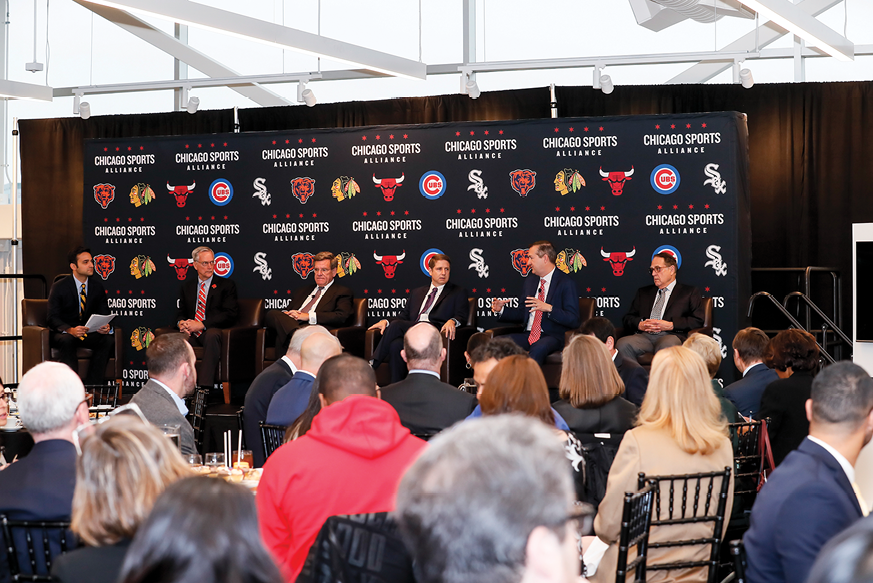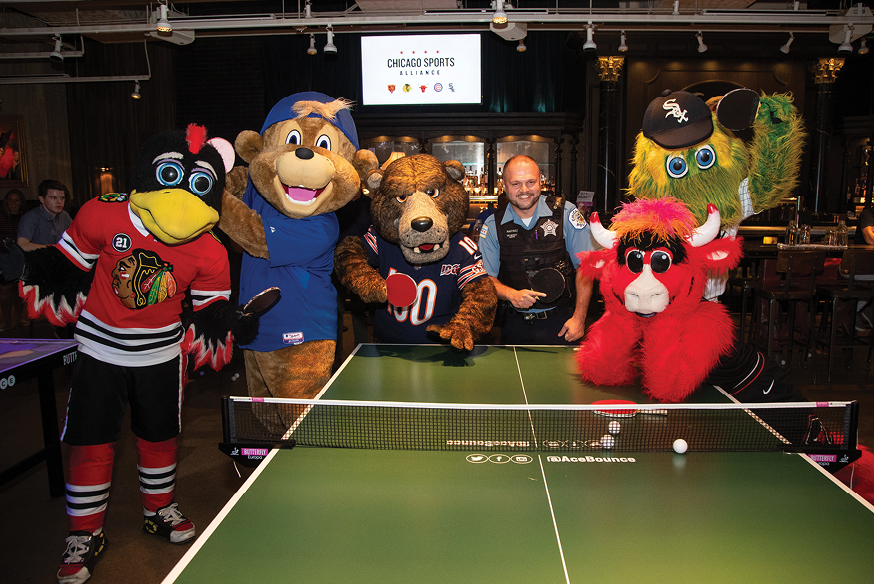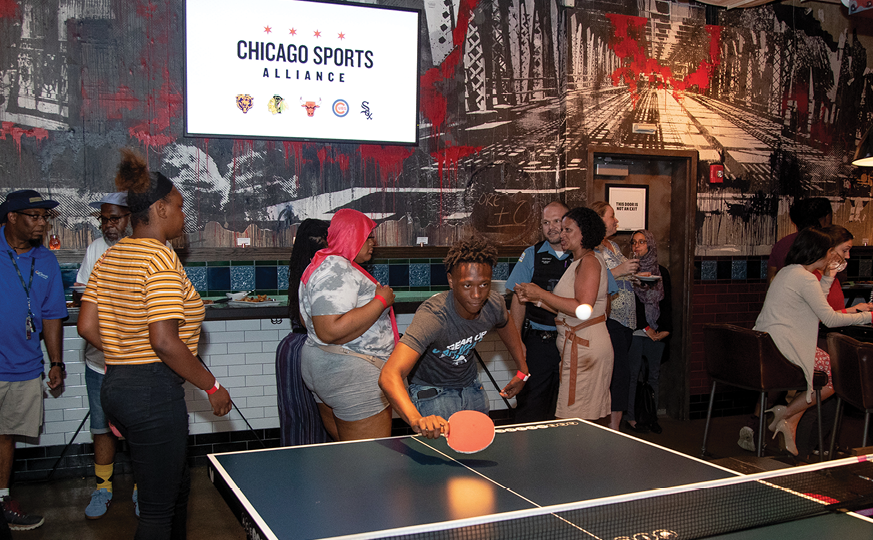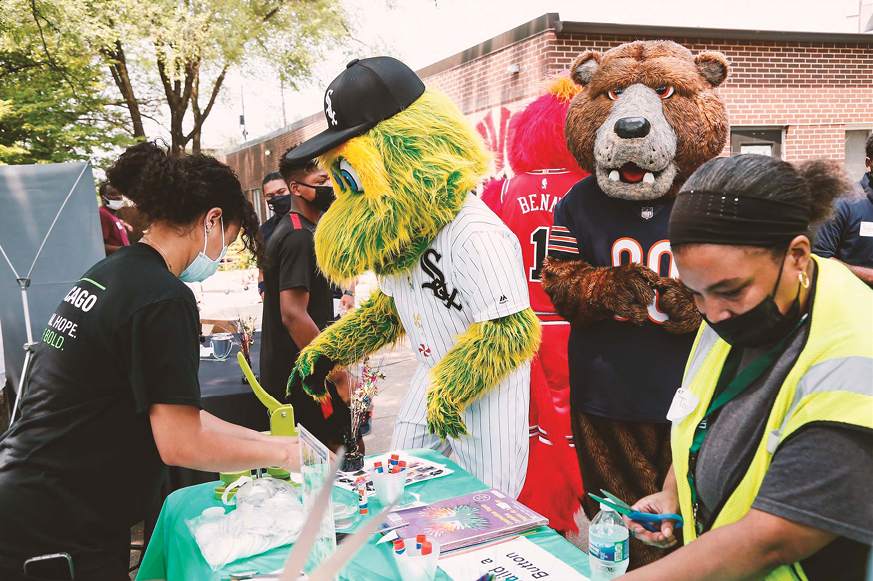- Home
- Media Kit
- MediaJet
- Current Issue
- Past Issues
- Ad Specs-Submission
- Ad Print Settings
- Reprints (PDF)
- Photo Specifications (PDF)
- Contact Us
![]()
ONLINE
![]()
ONLINE

Public Safety
Editors’ Note
Roseanna Ander serves as the founding Executive Director of the University of Chicago Crime Lab (since 2008) and the University of Chicago Education Lab (since 2011) with offices in Chicago and New York, which work to design, test and scale data-driven programs and practices that improve the public sector’s approach to public safety and education. Since their inception, she has led the Crime Lab and Education Lab’s efforts on violence prevention, criminal justice reform, and improved educational outcomes in Chicago, New York and around the nation. Ander also helped launch the University of Chicago Urban Labs network, with the creation of three new, independently run labs focused on poverty, health, and the environment. Early initiatives Ander spearheaded at the Crime Lab include an evaluation of Youth Guidance’s Becoming a Man program and an evaluation of a cognitive-behavioral therapy program delivered in the Cook County Juvenile Detention Center. Recently, she has helped move forward the Crime Lab and Education Lab’s evaluation of Children’s Home & Aid’s and Youth Advocate Programs, Inc.’s Choose to Change program, an innovative effort that engages youth heavily impacted by violence and trauma and connects them with intensive advocate and wraparound supports along with trauma-informed therapy. Ander was also instrumental in helping launch the Rapid Employment and Development Initiative (READI), a program that connects men most at risk for violence involvement and victimization with cognitive-behavioral therapy, jobs, and wraparound supports. She has worked intensively on the Education Lab’s efforts to support Chicago Public Schools on personalized learning and other innovative ways to improve educational outcomes for all children. She was also key in navigating police training and reform efforts within the Chicago Police Department (CPD), including the Crime Lab’s study of CPD’s Officer Support System, a first-of-its-kind, data-driven early intervention system that flags officers at risk for adverse events and provides training and support to help avert tragic incidents between police and residents before they occur. Ander was instrumental in the production and release of the City of Chicago’s Violence Reduction Dashboard, a tool for nonprofit organizations, the media and the general public, which provides near-real-time data and visualizations of violence trends. During her time at the Crime Lab and Education Lab, Ander has also served on the public safety transition teams for Chicago Mayor Rahm Emanuel, Chicago Mayor Lori Lightfoot and Illinois Governor Bruce Rauner. Prior to joining the University of Chicago, Ander oversaw the Joyce Foundation’s gun violence program, which included helping provide seed funding for the National Violent Death Reporting System (NVDRS), a state-based reporting system, and a seminal report on Firearm Violence for the National Academy of Sciences in 2005. She also led Joyce’s grantmaking in early childhood education. Before Joyce Foundation, Ander was a Soros Justice Fellow with the Massachusetts Attorney General’s Office and worked for the Harvard Injury Control Center and the Harvard Project on Schooling and Children. Ander holds an MS from the Harvard School of Public Health.
Institution Brief
Scientific research has dramatically changed the understanding of what drives human behavior and what types of social conditions are the most important risk or protective factors for violence involvement. The University of Chicago Crime Lab (urbanlabs.uchicago.edu/labs/crime) uses insights from basic science to help government agencies and nonprofit organizations develop and rigorously test innovative approaches to reducing crime and violence. It also combines lessons from randomized experiments with machine learning and predictive analytics to help better understand who benefits most from policy interventions and why as a way to improve targeting and ensure successful scale-up.
Will you provide an overview of the University of Chicago Crime Lab and how you define its purpose?
In 2007, after the tragic, fatal shooting of a University of Chicago doctoral student, Professors Jens Ludwig and Harold Pollack and I realized that the university stood to play a much larger role in making Chicago safer and more just. We founded the Crime Lab, an independent research organization that designs, tests, and scales data-driven innovations that simultaneously advance gun violence prevention and criminal justice reform.
Working with public sector agencies to improve their response to these two crises is central to the Crime Lab’s purpose. There are two reasons why: first, the impact of these issues isn’t equitable – communities of color are disproportionately harmed by the toll of these problems and our government’s failed attempts to address them; and second, it’s the best way to make progress at scale.
“In 2007, after the tragic, fatal shooting of a
University of Chicago doctoral student,
Professors Jens Ludwig and Harold Pollack and I realized that the university stood to play a much
larger role in making Chicago safer and more just.
We founded the Crime Lab, an independent research organization that designs, tests, and scales data-driven innovations that simultaneously advance gun violence prevention and criminal justice reform.”

Chicago Sports Alliance 2018 event - Courtesy of Chicago Bears
How is the University of Chicago Crime Lab working to improve the public sector’s response to the dual crises of gun violence and America’s broken criminal justice system?
For too long, our elected officials have viewed addressing gun violence and criminal justice harms as zero-sum: either we can reduce gun violence, or we can reform the justice system. So during surges in gun violence – like the one we’re experiencing now – we’ve historically seen calls for harsher “tough on crime” policies. But those punitive measures have harms of their own that often impact the very communities most affected by gun violence. That’s why the Crime Lab is focused on improving how the public sector responds to both crises simultaneously.
We do this in a few ways. First, we work with the public sector directly through partnerships with entities like the Chicago Public Schools and the Chicago Police Department. For example, we helped stand up and bring on a treatment provider, Thresholds, to work with the Chicago Police Department to divert opioid users away from arrest and into treatment. We are working with these groups to evaluate a pilot of their “Narcotics Arrest Diversion Program” which has allowed over 800 Chicagoans to receive addiction treatment rather than be charged with a crime. Early results from the program found it reduced the rearrest rate among participants by 44 percent.
We also partner with nonprofit organizations to help design and evaluate their programming with the idea that by proving an intervention works, we make it more possible for policymakers to fund and scale it. That’s exactly what happened with Becoming A Man (BAM), a program run by the nonprofit Youth Guidance that offers weekly mentoring, cognitive behavioral therapy and educational enrichment to high school boys at risk of gun violence involvement. Our evaluation of BAM – finding that it cut participants’ violent crime arrests in half and boosted their high school graduation rates by nearly 20 percent – led to then-Chicago Mayor Rahm Emanuel investing $36 million into the program and other similar mentoring programs. It also informed President Obama’s My Brother’s Keeper initiative, which now operates in 35 states.
“Our contributions through the Chicago Sports Alliance are about more than financial support. We want to form meaningful relationships with these organizations and are proud to provide new opportunities and experiences to the young men in the READI Chicago program, and others, as part of that work. It’s important for us to continue joining forces with partners like the Crime Lab and READI on measurable gun-violence reduction solutions.”
Matt Simeone
Director of Community & Alumni Relations,
Chicago Bears
What are the keys to driving sustainable change in the fight against gun violence?
First, it’s important to understand what gun violence in America actually looks like. There’s an idea that most gun violence is “rational” in that it’s a cost-benefit type analysis in which shootings are pre-planned and thought through. But in fact, the vast majority of murders in America are not motivated by money, robberies, or wars between gangs over drug turf. They are most often the result of an argument that spins out of control. In Philadelphia, for instance, the city recently found that half of homicides were sparked by arguments.
That means one way to reduce gun violence is to make the situations in which those arguments occur more forgiving. The best way to do that is to limit the widespread availability of illegal guns. By the Crime Lab’s estimate, illegal gun carrying in Chicago increased by over 100 percent in 2020, driven largely by guns trafficked into Chicago from outside states. Without the presence of a gun, altercations would still happen, but they would be far less likely to result in death.
Fair and effective policing is also critical to help to de-escalate arguments and discourage illegal gun carrying. But policing being “fair and effective” is key. Research shows that when the relationship between police and communities erodes, the public’s willingness to report crimes declines, making people more likely to turn to self-enforcement and retaliation instead of the criminal justice system.
Another area of opportunity is Community Violence Intervention (CVI) programs, which have been shown to help people de-escalate stressful situations before they lead to violence. BAM, which I mentioned earlier, is one example. Another is READI Chicago, a CVI program the Crime Lab is evaluating that connects the men most at risk of gun violence involvement with trauma-informed therapy and support that was invested in by the Chicago Sports Alliance. Thirty-five percent of READI participants have previously been shot. Ninety-eight percent have been arrested at least once, with an average of 17 arrests. These are the men for whom our society provides no social safety net; men who other interventions historically struggle to reach. READI is changing that.
In order to drive sustainable change in the fight against gun violence, we need to address the root causes of gun violence and make situations more forgiving. Data and research from Chicago and cities around the country show this is possible.
“The Chicago Sports Alliance represents what’s possible through the power of sports, bringing communities together, building authentic relationships, and supporting community-led solutions. The Chicago Blackhawks are proud to work alongside our sports team partners to direct resources and attention towards such a critical issue facing Chicago. We stand alongside community leaders as they work tirelessly in their neighborhoods to end gun violence in our city.”
Sara Guderyahn
Vice President, Community, Chicago Blackhawks, and
Executive Director, Chicago Blackhawks Foundation

Chicago Sports Alliance 2019 event - Courtesy of Chicago White Sox
How critical are metrics to track the impact of the University of Chicago Crime Lab’s initiatives?
Being data-driven – and using metrics to track our impact – is at the very core of the Crime Lab’s work as a research institution. Our goal is to have an outsized impact on our streets, in our courts, and across our justice system to support neighborhoods that have disproportionately suffered from the twin crises of gun violence and a broken criminal justice system for generations. We believe that the best way to do that is by harnessing data through rigorous, scientific evaluations to help cities and community-based organizations identify the most innovative and effective policies or programs.
We do research and publish the results in scientific journals, but we also believe it’s critical to put data directly in the hands of residents. That’s why we partnered with the City of Chicago and dozens of community organizations to create the Violence Reduction Dashboard, which granted the public unprecedented access to near real-time data on gun violence to help target resources and identify violence reduction strategies.
“As White Sox Chairman Jerry Reinsdorf has said, it is our responsibility to be a champion for our city and our fans who have given us so much. The Chicago Sports Alliance represents five iconic sports franchises standing together united against gun violence that has adversely impacted the lives of too many Chicagoans. We are grateful to lend the collective power and resources of the Alliance to our partners at the Crime Lab and READI Chicago who are transforming the lives of individuals on a daily basis through tested, evidence-based programs.”
Christine O’Reilly
Vice President of Community Relations,
Chicago White Sox, and Executive Director,
Chicago White Sox Charities
The University of Chicago Crime Lab has worked with the Chicago Sports Alliance since the Alliance was created. Will you highlight this partnership and how the two organizations have collaborated?
In 2017, the five iconic Chicago sports franchises – the Bears, Blackhawks, Bulls, Cubs, and White Sox – came together to form the Chicago Sports Alliance in support of impactful, evidence-based solutions to gun violence in the city. Since the Alliance’s inception, the Crime Lab has worked closely with the teams to identify those solutions and direct over $4 million in grants. Since 2019 the Robert R. McCormick Foundation has provided an additional $1.5 million in matching grants to expand the collective work of the Chicago Sports Alliance.
In just five years, the Alliance has been enormously impactful – for instance, through the Alliance’s investment in Choose to Change (C2C), a program reaching Chicago students at risk of gun violence who have become disengaged from the public school system. This program engages youth heavily impacted by violence and trauma by connecting them with intensive advocate and wraparound supports along with trauma-informed therapy to help them live safe and successful lives. The Crime Lab was able to show that the C2C program reduced participants’ violent crime arrests by 48 percent. In response to our findings, the City of Chicago and Chicago Public Schools expanded C2C to serve more than 2,000 students at the highest risk of gun violence involvement over three years. Additionally, the C2C providers are putting together a manual of the program to help other organizations across Chicago provide this high-quality program to more youth.
In addition to Choose to Change, the Sports Alliance has donated both their time and their funds to the READI Chicago Program. READI connects men at the highest risk of gun violence with trauma-informed therapy and jobs. One of the program providers, former Director Eddie Bocanegra, has gone on to become an advisor for Attorney General Merrick Garland. He is providing advice to the Justice Department on CVI. With Bocanegra’s move to the federal government, we are seeing our theory of change in action as Bocanegra is now instrumental in steering hundreds of dollars towards evidence-backed interventions.
“The Bulls are dedicated to using its platform
to tackle some of Chicago’s toughest issues and
are grateful for the opportunity to amplify our community efforts through the Chicago Sports Alliance. This unique partnership demonstrates the collaborative approach needed to tackle gun
violence in our city and the responsibility of
Chicago’s sports teams to uplift the communities
that support our teams day in and day out.”
Adrienne Scherenzel-Curry
Vice President of Community Relations,
Chicago Bulls

Chicago Sports Alliance 2019 event - Courtesy of Chicago White Sox
What do you see as the role that Chicago’s professional sports teams can play in addressing societal issues such as gun violence and how valuable has it been to have such engagement and commitment from the teams?
The great power of the Alliance is that it uses the reach and resources of five of Chicago’s major sports teams to engage the entire city on its most urgent challenge. It goes beyond dollars. Never before have the teams’ owners worked collectively on an issue of such importance to Chicago. By showing that they are on the same team when it comes to reducing gun violence, the Alliance highlights that the violence Chicago experiences is everyone’s problem, and we have to work together to solve it.
Many Chicago teams play on the South and West sides, where the violence is concentrated. By giving back to the city – in a way that’s informed by the data – the Alliance shows that everyone in a leadership position in the city has a responsibility to stand together against the unacceptable level of community violence.
“As gun violence continues to plague our Chicago communities, the Chicago Sports Alliance remains committed to providing resources, funds and collective support to our nonprofit partners in an effort to implement impactful solutions that decrease gun violence throughout our beloved city. Our partners have done a tremendous job creating effective programs based on thorough research and analysis and we look forward to continuing to support their efforts in our fifth year as the Alliance.”
Alicia Gonzalez
Executive Director,
Cubs Charities

Chicago Sports Alliance 2021 event - Courtesy of Chicago White Sox
What are your priorities for the University of Chicago Crime Lab as you look to the future?
We will always have a special commitment to Chicago and the problems it faces. Right now, the data illuminates two issues that we’re prioritizing in our hometown. First, we’re in the midst of a gun violence crisis. Between 2019 and 2020, there was the largest one-year rise in the homicide rate in 50 years, and that increase spilled over into 2021 and now 2022. Chicago has been hit particularly hard. We ended last year with over 800 homicides, a 60 percent increase relative to 2019. The pandemic is certainly a contributing factor to this recent spike, but more research is needed to determine its drivers and find solutions to stem this crisis.
Second, we’re prioritizing closing the widening gap in public safety between Chicago’s Black and white, and high-income and low-income residents. In 2020, the gun homicide rate in Chicago’s four most violent police districts was 25 times higher than in the four least violent police districts. In 1991, the rate was 13 times higher – meaning since the ’90s, the public safety gap has doubled in Chicago.
Reflecting on our current gun violence crisis and safety gap, it is hard to dispute that the situation in Chicago is dire. You can look at these numbers and feel daunted. You can look at these numbers and want to give up. Or, you can look at these numbers, roll up your sleeves, and continue to work…that’s what we are doing at the Crime Lab, with the help of the Chicago Sports Alliance, the Robert R. McCormick Foundation, and others. Our home city is one of the world’s greatest and has the potential to be a positive source of growth and culture. We want to do our part to help that potential be realized for each and every Chicagoan, starting with the most basic requirement: public safety.![]()